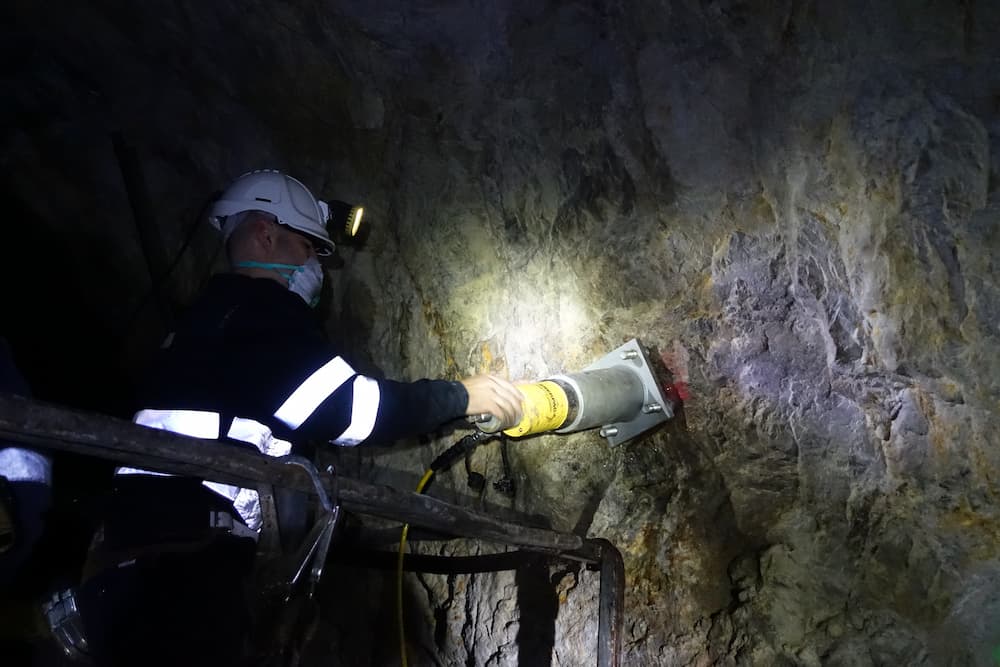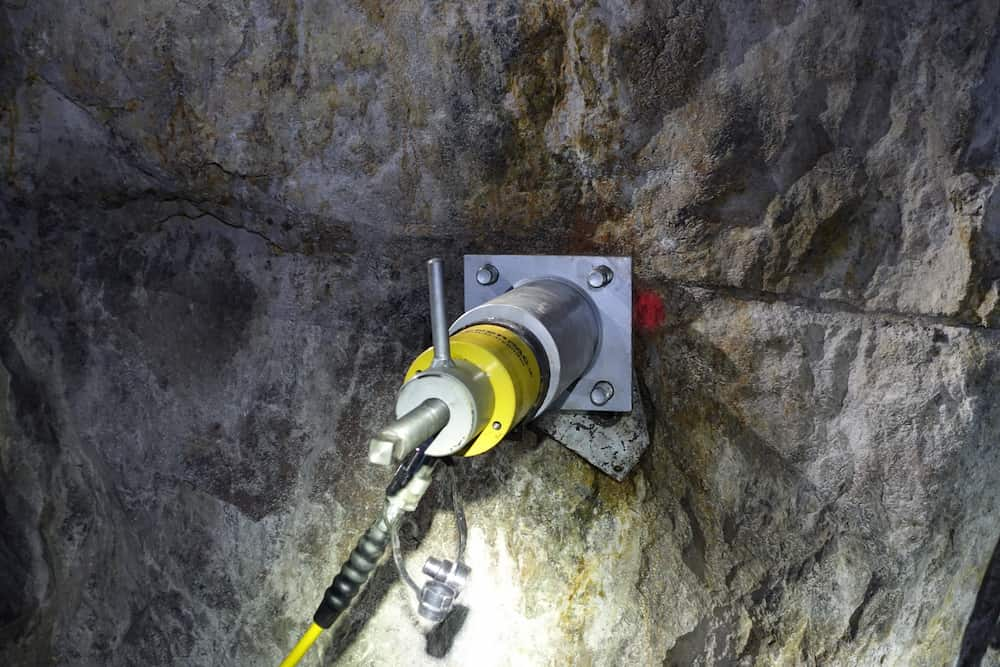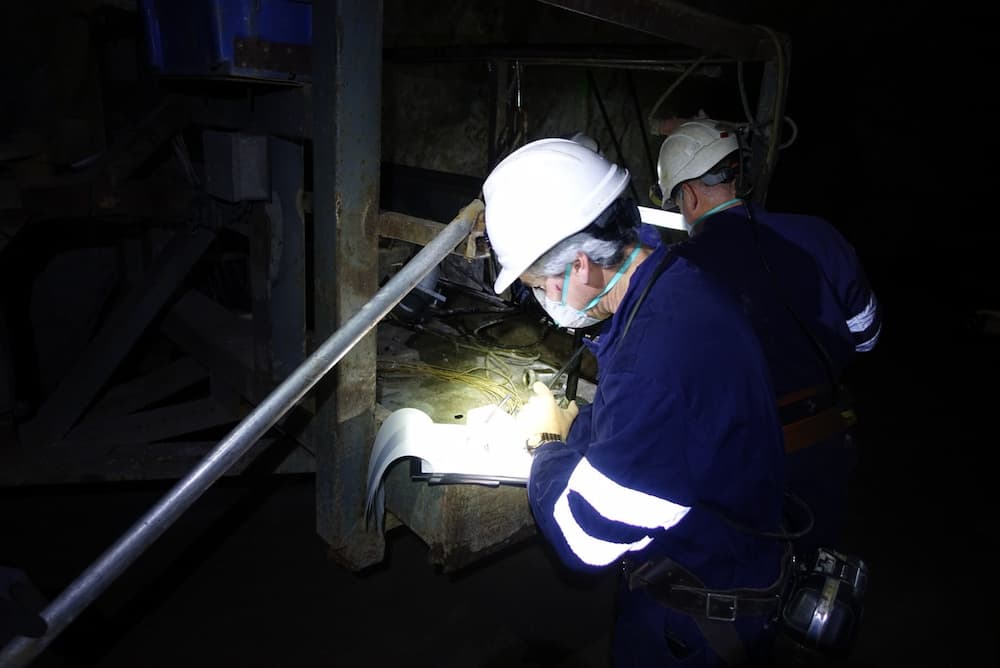EMC Expandable rock bolts ensure maximum safety for underground operations
Our EMC Expandable rock bolts are ground control elements for stabilising the rock mass in underground operations. It is always recommended to conduct site specific test to guarantee their correct installation and operation even though the bolts are of their highest quality and meet all international safety standards.
Expandable rock bolt’s pull tests are carried out in accordance with the standards set by the American Society for Testing and Materials (ASTM). This test evaluates the behavior of this type of bolt and its optimum performance.
What is a rock bolt pull test?
This test consists of a mechanical test that is carried out on the expandable rock bolt installed in rocky walls or ceilings of underground galleries. It aims to measure the tensile capacity, the deformation and behavior when a load is applied.
Using hydraulic equipment, the maximum necessary force is applied to verify whether the bolt remains anchored to the rock mass.
With regard to the pressure applied during this test, there is no fixed standard; it depends on the testing authority or the protocols and requirements of each case. However, consideration is typically given to the nominal load carried by the bolt, which can be classified into three types:
- 120 kN
- 160 kN
- 240 kN
Each underground operation has a considerable number of bolts installed, and the test is not performed on all of them, but randomly. And, the objective is to verify that the bolts are installed correctly, and that all the mine’s geomechanical methodology and safety criteria have been met.
For most uses, pull tests are requested by the person in charge of the underground operation. However, they can also be carried out at the initiative of the company supplying the bolts if any incident is detected.
Types of tensile tests

We differentiate between two types of tests, even though the test shares the purpose of both evaluating the material (which depending on the force applied to the expandable rock bolt) and the final specific objective.
Non-destructive pull test
In the non-destructive tensile test, a maximum pressure load is set, which is usually 80%. Once this measurement is reached, the test is completed and the bolt is checked for any kind of alteration or damage. It is a quick and efficient way of detecting possible anomalies.
Destructive pull test
In the destructive pull test, the load is increased until the bolt breaks. Irrespective of the type of test and the size of the bolt, the methodology applied is the same. What varies is the pressure of the applied force.
What data is needed to carry out the tensile test?
When carrying out a test of these characteristics, a series of variables must be taken into account.
The location
Normally the tests are usually carried out in excavated galleries, so it is important to define if the bolts will be in the gables or in the vault.
Diameter of the borehole
It is important to assess the drilling diameter depending on the type of bolt to be tested. If it is too small, it will prevent the bolt from entering the ground, while if it is too large, it is likely that when it expands it will not achieve sufficient pressure on the walls of the ground.
Date of installation
The time elapsed between installation of the expanding bolt and the time of the pull test can influence the result.
After long periods from installation, we can sometimes find wear due to oxidation caused by the circulation of highly corrosive acidic water, tectonic movements in the area, or blasting that has been carried out in the mine.
Lithological information
Data on lithology, such as RMR or Young’s modulus data, is often requested from the Underground Operation Manager to gain a more accurate understanding of the rock properties.
Expandable rock bolt pull test equipment and materials

The pull-test equipment and materials consists of:
Cherry Picker (Elevation Platform) use
An elevated platform could be required to reach the bolt if it is at a great height.
Clamp
A clamping element that secures the bolt during the extraction process is essencial.
Hydraulic equipment
A hydraulic pump is used to transfer pressure to the bolt in order to apply the force required for the test. For this purpose, a connecting element between the clamp and the cylinder is necessary.
Steps to be followed to carry out the expandable rock bolt pull test
The process for the tensile test can be summarised in the following steps:
- Define the installation point of the expandable rock bolt.
- Drill the borehole in the rock according to the appropriate diameter.
- Insert the bolt
- Apply the estimated pressure for perfect expansion in the hole.
- Place the clamp on the bolt bushing and connect it to the hydraulic equipment.
- Exert the maximum force necessary with the aid of the jack to obtain the test results.
Measurements and analysis of results

At the end of the test, the results are recorded on a graph in the form of a curve representing the applied load and the elongation of the bolt based on the applied stress. In this way, a kind of DNA of the bolt is obtained.
If the test result is positive, it shows that the expandable rock bolt is installed correctly and is fulfilling its function of stabilising the rocky ground.
If, on the other hand, the bolt is installed incorrectly, because the diameter is not adequate or defects are found, additional work will have to be carried out to prevent this problem from affecting the stability of the rock mass. In this event, it will be necessary to place some additional bolts to ensure the safety of the installation.
In summary
The expandable rock bolt pull test not only evaluates the strength and quality of this type of bolt. It also makes it possible to detect possible anomalies caused by incorrect installation or wear and tear.
Furthermore, this type of test is an excellent benchmark for bolts manufacturers to continue to innovate and improve their products. By conducting their own testing in known and controlled areas, manufactures seek to push the limits of the product. They also can study how it responds in adverse environments in order to achieve better quality and greater safety.
About Onix Underground- the power of safety.
At Onix Underground, we are experts in expandable rock bolts and the stabilisation of rock masses in underground and mining operations. Our teams perform pull tests of expandable rock bolts both in our clients’ underground operations, and in our own testing laboratory, in order to always deliver the best quality product. This guarantees maximum quality and safety both for your personnel, and your operations.


